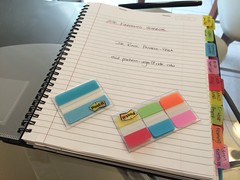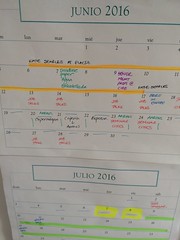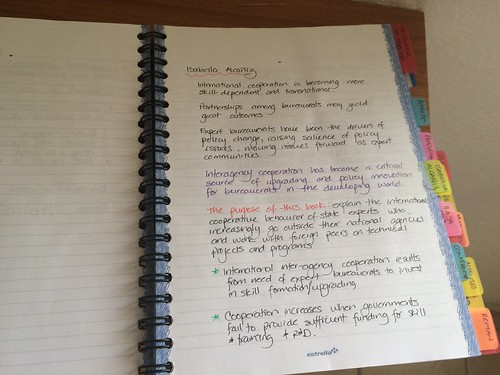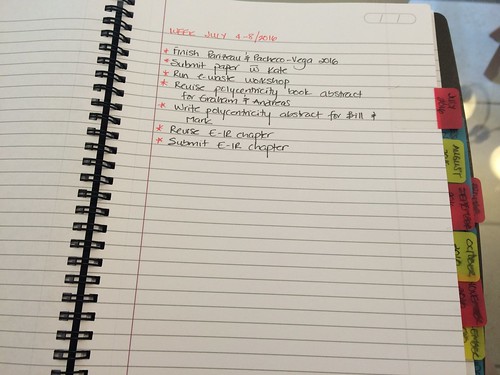 I have very odd methods of doing things, I recognize this. I don’t follow anybody’s “time management system”. I adopted many of the tips that are now praised in the methodologies that “Getting Things Done“, “the Bullet Journal” and other productivity systems boast since I was a child, and I’ve faithfully kept my working habits, so it’s sometimes weird to see them called someone else’s philosophy when I learned how to do them in my childhood. To be honest, I had a homework notebook since I was in grade school (I studied with the LaSalle system).
I have very odd methods of doing things, I recognize this. I don’t follow anybody’s “time management system”. I adopted many of the tips that are now praised in the methodologies that “Getting Things Done“, “the Bullet Journal” and other productivity systems boast since I was a child, and I’ve faithfully kept my working habits, so it’s sometimes weird to see them called someone else’s philosophy when I learned how to do them in my childhood. To be honest, I had a homework notebook since I was in grade school (I studied with the LaSalle system).
Our daily homework agenda (“diario de tareas” in Spanish) was a little notebook with space for every day of the week, where the teacher asked us to write down every piece of homework we had to do. Like a ‘homework journal’. Because I did my schooling with very strict teachers, they would review our “Homework Journal” every single day, and we had to have our parents sign it. Every. Single. Day. So, I got used to writing down what tasks I had to complete and by when. I don’t think I still have a copy of my “Homework Journal” from when I was little, or I would totally post it. Trust me, it worked. I never missed a piece of homework because I *had* to show it to my parents and they *had* to sign off on each page.
 A lot of people have seen how I work since I started publishing my “My Own Workflow” posts. Many folks ask me how I plan my days, weeks and months. Since July 1st was just a little while ago, and I’m a big believer in tracking progress (because you can’t fix what you can’t measure as per the first principle of total quality control), I decided to take stock of what I had accomplished in the first semester of the year. I also wanted to plan for the fall. I was curious to see what other people were doing for their To-Do lists, and contrast their process with mine. In a brief exchange with my graduate school friend Dr. Amanda Bittner (Memorial University of Newfoundland) and Dr. Andrea Collins (University of Waterloo), Andrea mentioned the “Bullet Journal“, a planning system that is basically a series of itemized to-do lists (monthly, weekly, daily plans).
A lot of people have seen how I work since I started publishing my “My Own Workflow” posts. Many folks ask me how I plan my days, weeks and months. Since July 1st was just a little while ago, and I’m a big believer in tracking progress (because you can’t fix what you can’t measure as per the first principle of total quality control), I decided to take stock of what I had accomplished in the first semester of the year. I also wanted to plan for the fall. I was curious to see what other people were doing for their To-Do lists, and contrast their process with mine. In a brief exchange with my graduate school friend Dr. Amanda Bittner (Memorial University of Newfoundland) and Dr. Andrea Collins (University of Waterloo), Andrea mentioned the “Bullet Journal“, a planning system that is basically a series of itemized to-do lists (monthly, weekly, daily plans).
@amandabittner @raulpacheco It's a systematized journal of to-do lists. It solved my problem of having post-its everywhere!
— Andrea Collins (@A_M_Collins) June 30, 2016
The Bullet Journal sounds good in theory, but as Jennifer Kerner Parkin wrote on her blog, it’s not really very good for academics who usually don’t think in linear models.
I tried the #bulletjournal for several months. Here are three reasons why I'll never use it again: https://t.co/gOmCie1Aal #productivity
— Jennifer M.K. Parkin (@JMKernerParkin) July 1, 2016
I work with a very different but (in a strange way) somehow similar version of what the “Bullet Journal” seems to teach (a system which I developed completely separately from the bullet journal model throughout the years, and modeled very much after my Homeworks’ Notebook). My model is simple: I plan for the year, then semester, then month, then week. I also have just ONE notebook: It’s My Everything Notebook.
I divide my plans in four sets of items: Student Mentorships (be it undergraduate or graduate), Research (which can be notes about journal articles, ideas I have about new papers, project tracking, research meetings notes, etc), Personal and Administrative (project management and daily stuff that doesn’t really add much value but is stuff you NEED to do anyways) and Teaching (which is usually notes about my syllabus, how I develop lesson plans, etc.).
 For my writing output, the main overarching framework that organizes my papers is my Publications Planner. I draw from the general “What Remains to be Done” cell and send it to my weekly plan. I plan for journal article and book chapter submission from the same Publications Planner and put it in my 6 Months-Monthly Plan (which is a series of printed monthly calendars that I then glue together to give me a general overview of the semester. I put together a weekly plan that is drawn from the Publications Planner, the semester calendar (I teach two courses in the fall), and some meetings that I already know I will have in the fall. Now that I have a newly funded project, I am going to have to schedule time for meetings and fieldwork for that one. I also make sure to include actual personal time and items in my planner (e.g. grocery shopping, laundry, weddings, birthdays etc.)
For my writing output, the main overarching framework that organizes my papers is my Publications Planner. I draw from the general “What Remains to be Done” cell and send it to my weekly plan. I plan for journal article and book chapter submission from the same Publications Planner and put it in my 6 Months-Monthly Plan (which is a series of printed monthly calendars that I then glue together to give me a general overview of the semester. I put together a weekly plan that is drawn from the Publications Planner, the semester calendar (I teach two courses in the fall), and some meetings that I already know I will have in the fall. Now that I have a newly funded project, I am going to have to schedule time for meetings and fieldwork for that one. I also make sure to include actual personal time and items in my planner (e.g. grocery shopping, laundry, weddings, birthdays etc.)
On my campus office whiteboard I write the five days of the week and type under each the day of the week what I’m supposed to be doing that day. That information comes from my weekly plan, and it’s integrated with my daily plan (see below). I make sure that I synchronize my daily and weekly plans with my Google Calendar (because let’s face it, I can get distracted rather easily). See below for analog synchronization of daily plan in the Everything Notebook with a weekly layout on the whiteboard.
As you can see, I moved things around, things "happened" (green) and stuff got done (crossed) – still working! pic.twitter.com/xWPIBGfAWS
— Dr Raul Pacheco-Vega (@raulpacheco) June 7, 2016
Because I used to List All The Things and I wanted to Achieve All The Goals, and I suddenly realized I can’t really do that, I changed my system to simply listing the stuff that MUST BE DONE, AND IS ACTUALLY FEASIBLE OF BEING COMPLETED BY THE DATE WHEN I PLANNED IT. This is important because I am always shooting for achieving more and then realizing my body (or life) happens.
I don't "Bullet Journal". I do write tasks to do, those completed get a ? – green ink is "Stuff that Came Up" pic.twitter.com/kMoK0816X7
— Dr Raul Pacheco-Vega (@raulpacheco) July 2, 2016
The question that I get asked All The Time: DON’T YOU SPEND MORE TIME PLANNING THAN ACTUALLY DOING THE WORK? My response to that question is always the one shown in this magnet (which is also in my campus office): I am just too lazy to look for things. So I make it super easy for me to find *everything* I do. Notes from a meeting. Research findings. My plan for a certain week. Because EVERYTHING is in my Everything Notebook, I really don’t have to look for anything. I just need to organize it once (and this July it took me about 45 minutes of one lazy Saturday).
Now you understand why I am so obsessively organized with my time, my books, my journal articles and my life ?? pic.twitter.com/pjmdhYoppl
— Dr Raul Pacheco-Vega (@raulpacheco) March 26, 2016
My process is actually quite simple, and I am happy to share it because if it can help someone else organize their thoughts or life, all the better. It does help me. And reflecting on my own processes helps me think about how to improve.



Dear Professor Pacheco-Villega, I found your blog while searching for time-management methods. You are a God-send. Honestly, your tools are excellent. I already started “My Everything Journal.” I am planning my weeks and days with the journal, which is also derived from my monthly calendars. However, I see you have other tabs in the journal that are about research, conferences, etc. Do you have two separate journals? Or do you have literally everything in one?
Thank you for making this blog. It has been truly helpful.
I keep one single Everything Notebook! Glad to hear it helps you!
Dr. Pacheco-Vega,
What is the difference between a bullet journal and the system you use?
They are entirely different. One is just a to-do list with a very simplified model (Bullet Journal). In my method, one adds everything into the Everything Notebook. Field notes, notes about articles, etc.
Hi Dr Pacheco-Vega,
Does putting everything in one journal not mean you fill it up frequently? What do you do when you run out of space?
Hi Kevin,
Yes, it does. When I run out of space in one of my Everything Notebooks, I start a second one and I use a plastic arrow to link from one to another. I will see if I can do a Twitter thread (@raulpacheco is my Twitter ID) or a blog post explaining this idea.
I am always impressed by people who can organize their life, and your system looks very good. You said “people who are organized are just too lazy to look for things”. But those who are not(like me) are too lazy to set up an organization system, they think they can find everything in their mind which becomes cluttered. It is very difficult for me to be organized, i get easily bored within 2 days. It drains me to try to be something i am not, it takes all my time to try to be organized. And i don t have the energy to go beyond this phase, to do the main task, writing my research. That is one of the reasons of my “stuckness”.
I was wondering what size book works best for the everything note book?
I was wondering what size notebook you use and if you can post pictures of your tabs that you have for sections